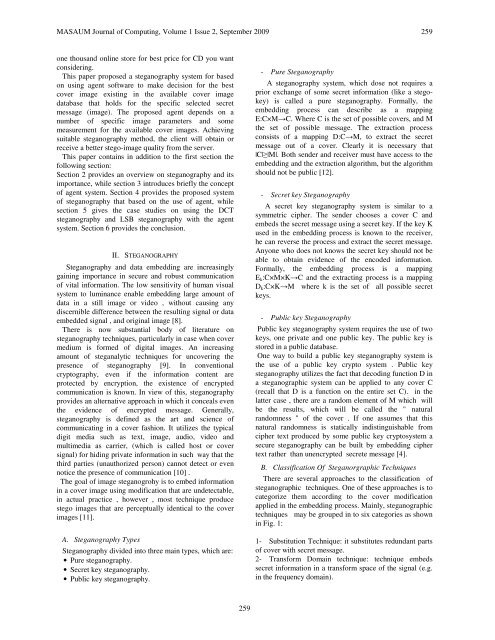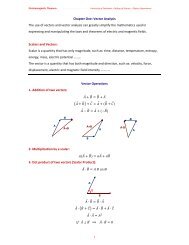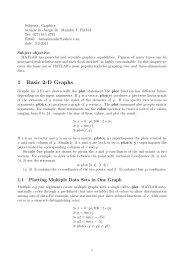An Agent based Image Steganography using Information Theoretic ...
An Agent based Image Steganography using Information Theoretic ...
An Agent based Image Steganography using Information Theoretic ...
You also want an ePaper? Increase the reach of your titles
YUMPU automatically turns print PDFs into web optimized ePapers that Google loves.
MASAUM Journal of Computing, Volume 1 Issue 2, September 2009 259<br />
one thousand online store for best price for CD you want<br />
considering.<br />
This paper proposed a steganography system for <strong>based</strong><br />
on <strong>using</strong> agent software to make decision for the best<br />
cover image existing in the available cover image<br />
database that holds for the specific selected secret<br />
message (image). The proposed agent depends on a<br />
number of specific image parameters and some<br />
measurement for the available cover images. Achieving<br />
suitable steganography method, the client will obtain or<br />
receive a better stego-image quality from the server.<br />
This paper contains in addition to the first section the<br />
following section:<br />
Section 2 provides an overview on steganography and its<br />
importance, while section 3 introduces briefly the concept<br />
of agent system. Section 4 provides the proposed system<br />
of steganography that <strong>based</strong> on the use of agent, while<br />
section 5 gives the case studies on <strong>using</strong> the DCT<br />
steganography and LSB steganography with the agent<br />
system. Section 6 provides the conclusion.<br />
II. STEGANOGRAPHY<br />
<strong>Steganography</strong> and data embedding are increasingly<br />
gaining importance in secure and robust communication<br />
of vital information. The low sensitivity of human visual<br />
system to luminance enable embedding large amount of<br />
data in a still image or video , without ca<strong>using</strong> any<br />
discernible difference between the resulting signal or data<br />
embedded signal , and original image [8].<br />
There is now substantial body of literature on<br />
steganography techniques, particularly in case when cover<br />
medium is formed of digital images. <strong>An</strong> increasing<br />
amount of steganalytic techniques for uncovering the<br />
presence of steganography [9]. In conventional<br />
cryptography, even if the information content are<br />
protected by encryption, the existence of encrypted<br />
communication is known. In view of this, steganography<br />
provides an alternative approach in which it conceals even<br />
the evidence of encrypted message. Generally,<br />
steganography is defined as the art and science of<br />
communicating in a cover fashion. It utilizes the typical<br />
digit media such as text, image, audio, video and<br />
multimedia as carrier, (which is called host or cover<br />
signal) for hiding private information in such way that the<br />
third parties (unauthorized person) cannot detect or even<br />
notice the presence of communication [10] .<br />
The goal of image steganogrohy is to embed information<br />
in a cover image <strong>using</strong> modification that are undetectable,<br />
in actual practice , however , most technique produce<br />
stego images that are perceptually identical to the cover<br />
images [11].<br />
A. <strong>Steganography</strong> Types<br />
<strong>Steganography</strong> divided into three main types, which are:<br />
• Pure steganography.<br />
• Secret key steganography.<br />
• Public key steganography.<br />
- Pure <strong>Steganography</strong><br />
A steganography system, which dose not requires a<br />
prior exchange of some secret information (like a stegokey)<br />
is called a pure steganography. Formally, the<br />
embedding process can describe as a mapping<br />
E:C×M→C. Where C is the set of possible covers, and M<br />
the set of possible message. The extraction process<br />
consists of a mapping D:C→M, to extract the secret<br />
message out of a cover. Clearly it is necessary that<br />
|C|≥|M|. Both sender and receiver must have access to the<br />
embedding and the extraction algorithm, but the algorithm<br />
should not be public [12].<br />
- Secret key <strong>Steganography</strong><br />
A secret key steganography system is similar to a<br />
symmetric cipher. The sender chooses a cover C and<br />
embeds the secret message <strong>using</strong> a secret key. If the key K<br />
used in the embedding process is known to the receiver,<br />
he can reverse the process and extract the secret message.<br />
<strong>An</strong>yone who does not knows the secret key should not be<br />
able to obtain evidence of the encoded information.<br />
Formally, the embedding process is a mapping<br />
E k :C×M×K→C and the extracting process is a mapping<br />
D k :C×K→M where k is the set of all possible secret<br />
keys.<br />
- Public key <strong>Steganography</strong><br />
Public key steganography system requires the use of two<br />
keys, one private and one public key. The public key is<br />
stored in a public database.<br />
One way to build a public key steganography system is<br />
the use of a public key crypto system . Public key<br />
steganography utilizes the fact that decoding function D in<br />
a steganographic system can be applied to any cover C<br />
(recall that D is a function on the entire set C). in the<br />
latter case , there are a random element of M which will<br />
be the results, which will be called the " natural<br />
randomness " of the cover . If one assumes that this<br />
natural randomness is statically indistinguishable from<br />
cipher text produced by some public key cryptosystem a<br />
secure steganography can be built by embedding cipher<br />
text rather than unencrypted secrete message [4].<br />
B. Classification Of Steganorgraphic Techniques<br />
There are several approaches to the classification of<br />
steganographic techniques. One of these approaches is to<br />
categorize them according to the cover modification<br />
applied in the embedding process. Mainly, steganographic<br />
techniques may be grouped in to six categories as shown<br />
in Fig. 1:<br />
1- Substitution Technique: it substitutes redundant parts<br />
of cover with secret message.<br />
2- Transform Domain technique: technique embeds<br />
secret information in a transform space of the signal (e.g.<br />
in the frequency domain).<br />
259

















